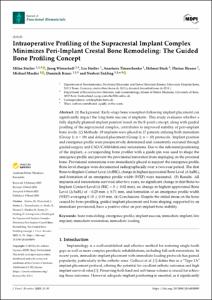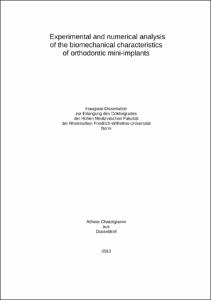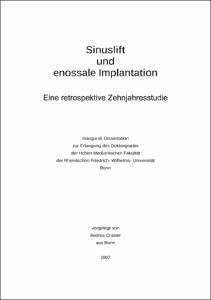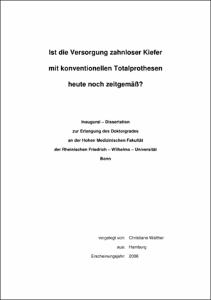Stoilov, Milan; Winterhoff, Joerg; Stoilov, Lea; Timoschenko, Anastasia; Stark, Helmut; Heuser, Florian; Marder, Michael; Kraus, Dominik; Enkling, Norbert: Intraoperative Profiling of the Supracrestal Implant Complex Minimizes Peri-Implant Crestal Bone Remodeling : The Guided Bone Profiling Concept. In: Journal of functional biomaterials. 2025, vol. 16, iss. 3, 93, 1-19.
Online-Ausgabe in bonndoc: https://hdl.handle.net/20.500.11811/13591
Online-Ausgabe in bonndoc: https://hdl.handle.net/20.500.11811/13591
@article{handle:20.500.11811/13591,
author = {{Milan Stoilov} and {Joerg Winterhoff} and {Lea Stoilov} and {Anastasia Timoschenko} and {Helmut Stark} and {Florian Heuser} and {Michael Marder} and {Dominik Kraus} and {Norbert Enkling}},
title = {Intraoperative Profiling of the Supracrestal Implant Complex Minimizes Peri-Implant Crestal Bone Remodeling : The Guided Bone Profiling Concept},
publisher = {MDPI},
year = 2025,
month = mar,
journal = {Journal of functional biomaterials},
volume = 2025, vol. 16,
number = iss. 3, 93,
pages = 1--19,
note = {(1) Background: Early-stage bone resorption following implant placement can significantly impact the long-term success of implants. This study evaluates whether a fully digitally planned implant position based on the E-point concept, along with guided profiling of the supracrestal complex, contributes to improved stability of peri-implant bone levels. (2) Methods: 29 implants were placed in 27 patients utilizing both immediate (Group 1; n = 19) and delayed placement (Group 2; n = 10) protocols. Implant position and emergence profile were preoperatively determined and consistently executed through guided surgery and CAD/CAM-fabricated restorations. Due to the subcrestal positioning of the implant, a corresponding bone profiler with a guide pin was used to shape the emergence profile and prevent the provisional restoration from impinging on the proximal bone. Provisional restorations were immediately placed to support the emergence profile. Bone level changes were documented radiographically over a two-year period. The first Bone-to-Implant Contact Level (∆ fBIC), change in highest approximal Bone Level (∆ haBL ), and formation of an emergence profile width (WEP) were measured. (3) Results: All implants and restorations survived after two years, no significant change in first Bone-to-Implant Contact Level (∆ fBIC = 0 ± 0.02 mm), no change in highest approximal Bone Level (∆ haBL ) of −0.23 mm ± 0.71 mm, and formation of an emergence profile width (WEP) averaging 0.18 ± 0.19 mm. (4) Conclusions: Despite the initial stress on the bone caused by bone profiling, guided implant placement and bone shaping, supported by an immediate provisional, have a positive effect on peri-implant bone stability.},
url = {https://hdl.handle.net/20.500.11811/13591}
}
author = {{Milan Stoilov} and {Joerg Winterhoff} and {Lea Stoilov} and {Anastasia Timoschenko} and {Helmut Stark} and {Florian Heuser} and {Michael Marder} and {Dominik Kraus} and {Norbert Enkling}},
title = {Intraoperative Profiling of the Supracrestal Implant Complex Minimizes Peri-Implant Crestal Bone Remodeling : The Guided Bone Profiling Concept},
publisher = {MDPI},
year = 2025,
month = mar,
journal = {Journal of functional biomaterials},
volume = 2025, vol. 16,
number = iss. 3, 93,
pages = 1--19,
note = {(1) Background: Early-stage bone resorption following implant placement can significantly impact the long-term success of implants. This study evaluates whether a fully digitally planned implant position based on the E-point concept, along with guided profiling of the supracrestal complex, contributes to improved stability of peri-implant bone levels. (2) Methods: 29 implants were placed in 27 patients utilizing both immediate (Group 1; n = 19) and delayed placement (Group 2; n = 10) protocols. Implant position and emergence profile were preoperatively determined and consistently executed through guided surgery and CAD/CAM-fabricated restorations. Due to the subcrestal positioning of the implant, a corresponding bone profiler with a guide pin was used to shape the emergence profile and prevent the provisional restoration from impinging on the proximal bone. Provisional restorations were immediately placed to support the emergence profile. Bone level changes were documented radiographically over a two-year period. The first Bone-to-Implant Contact Level (∆ fBIC), change in highest approximal Bone Level (∆ haBL ), and formation of an emergence profile width (WEP) were measured. (3) Results: All implants and restorations survived after two years, no significant change in first Bone-to-Implant Contact Level (∆ fBIC = 0 ± 0.02 mm), no change in highest approximal Bone Level (∆ haBL ) of −0.23 mm ± 0.71 mm, and formation of an emergence profile width (WEP) averaging 0.18 ± 0.19 mm. (4) Conclusions: Despite the initial stress on the bone caused by bone profiling, guided implant placement and bone shaping, supported by an immediate provisional, have a positive effect on peri-implant bone stability.},
url = {https://hdl.handle.net/20.500.11811/13591}
}









